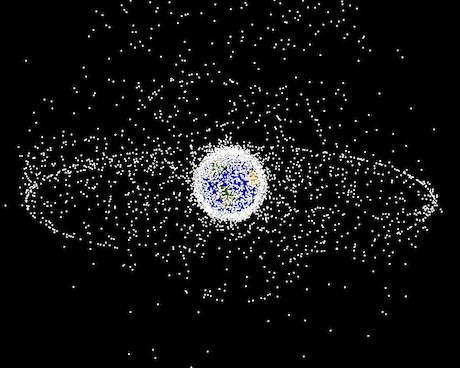Preventing Satellite Debris

My good friend Jeff Mann, the true Yard Ramp Guy, has asked me to revisit some of my original posts. This week in my From the Archives series: it's either space junk...or me, trying to make a pizza.

Space Junk
In 2013, director Alfonso Cuarón came out with Gravity, a movie about junk. Specifically, it's a movie about space junk.
In the film, a missile strike on a satellite results in a runaway chain reaction of collisions between space junk and satellites. This brings down space stations, satellites, and spacecraft left and right, rendering Earth's orbit useless to manned travel.
Gravity is an excellent movie, and we’ll forgive a few scientific inaccuracies, since they're all in service of the plot. (Neil Degrasse Tyson, despite his multiple criticisms of the science, is a fan of the film.)
The threat in Gravity is a very real one. It's a scenario known as Kessler Syndrome, where space debris collides with space debris, generating more space debris, which collides with yet more space debris, until that specific orbit around Earth is so filled with debris that it is rendered nearly useless for human purposes. (Low Earth orbit is the most likely orbit to be lost to this process, though geosynchronous orbit is another possible victim.)

Being Geosynchronous
It's not astonishing that this is a serious concern for NASA and other space scientists. There are more than 2,000 satellites in orbit, about 1,500 of which are operational, along with nearly 18,000 trackable artificial objects.
Smaller objects are even more common—at least 29,000 chunks of debris in orbit that are more than 10cm in size, nearly 700,000 between 1-10cm in size, and 170 million chunks of debris below 1 cm in size.
Even with how spacious Earth's orbit is, there's a very high chance of impact, and at least one satellite is destroyed by debris every year. Space junk is a serious threat even if it doesn't trigger Kessler Syndrome.
Steps are being taken to combat the risk. We're tracking debris much more carefully than ever right now. The International Space Station and other spacecraft have special protective layers known as Whipple shield: instead of building hulls out of thicker material, engineers add an extra thin layer some distance over the regular hull. The layer isn't meant to stop the debris but to break it into smaller chunks. In essence, Whipple shield turns debris from a bullet into birdshot. It even makes the needed thickness for the inner hull much smaller, so overall spacecraft mass is actually reduced.
And this: we’re developing a technology known as a laser broom. Targeting a laser on debris will heat up one side of the debris. The resulting heat emissions will then alter and destabilize the debris' orbit, causing it to burn up in the atmosphere.
Like me, trying to make pizza.
Yard Ramp Guy Blog: New & Noteworthy
The (real) Yard Ramp Guy has a grab-bag blog entry this week that involves a sales promotion, testimonials, turnkey services, and a way to get a better tax situation. I just love it when disparate tangents weave together.
Read all about it HERE.
